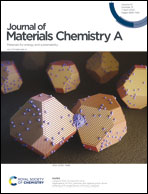Acoustotemplating: rapid synthesis of freestanding quasi-2D MOF/graphene oxide heterostructures for supercapacitor applications†
Abstract
Two-dimensional (2D) graphitic materials are often incorporated with metal–organic frameworks (MOFs) to compensate for the poor electrical conductivity of the latter, particularly if they are to be used for electrochemical applications. Nevertheless, the incompatibility between conventional three-dimensional (3D) MOF crystal morphologies with the 2D graphitic sheets often poses a challenge in the fabrication of planar heterostructures, therefore necessitating the addition of polymeric supports and binders. Herein, we report an acoustomicrofluidic method that enables rapid—within milliseconds—synthesis of homogeneous MOF/graphene oxide (GO) planar heterostructures without the need for such additives. In particular, the method harnesses the combination of the intense shear flow and slender-body geometrical confinement imposed by the spreading of a thin liquid film under high frequency electromechanical surface vibrations to drive in situ crystallization and in-plane templating of quasi-2D MOF crystals onto GO sheets simultaneously aligned into stacked layers by the flow. Unlike the 3D morphology of its conventional copper (Cu)-based MOF equivalent (HKUST-1), the unique quasi-2D MOFs that are produced possess large surface-area-to-volume-ratios and dense exposure of Cu sites on their surface that facilitate effective Cu/GO coordination. This ability to template the MOF directly onto the GO sheets allows for the construction of freestanding membranes that are sufficiently robust to withstand reduction of the GO to reduced graphene oxide (rGO) without compromising the integrity of the MOF crystal structure. We show that the synergistic coupling between the conductive rGO layers together with the redox-active surface Cu sites of the quasi-2D MOF enables excellent supercapacitor performance of this hybrid material—up to 292 F g−1 at a current density of 1 A g−1, which is approximately two orders of magnitude larger than its 3D HKUST-1/rGO counterpart.



 Please wait while we load your content...
Please wait while we load your content...